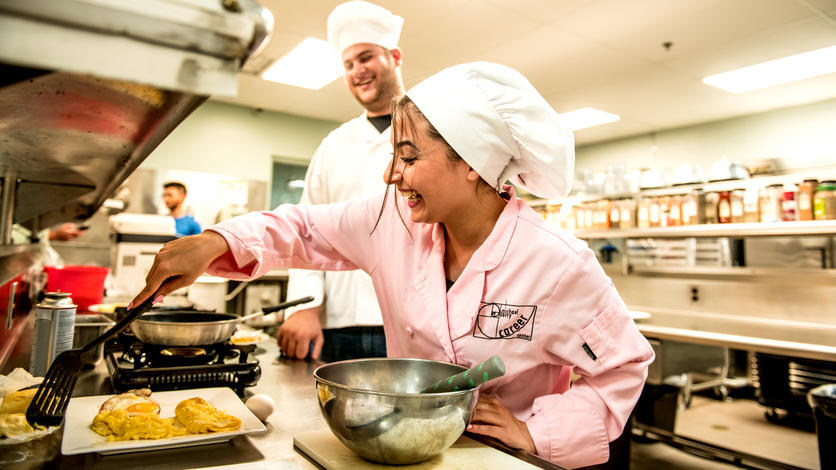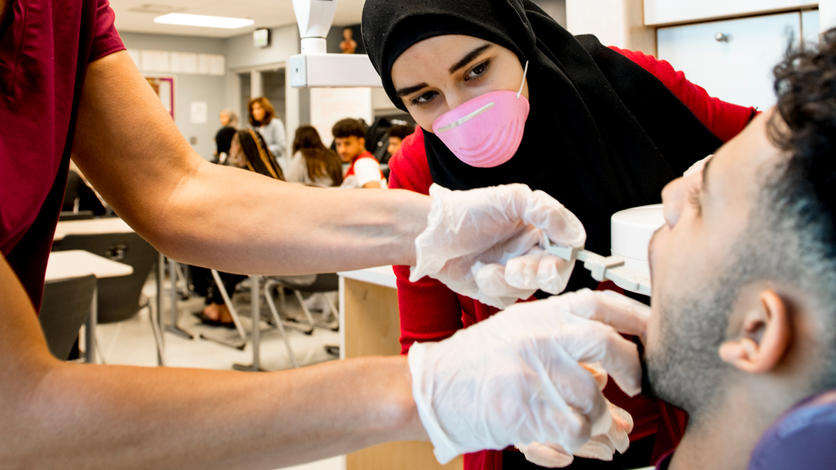
What Heyam Alcodray (’80 B.B.A.) is trying to do at Dearborn’s Fordson High School manages to feel both radical and comfortable. It’s radical in the sense that the new kind of high school experience the Fordson principal and UM-Dearborn alumna is creating dares to redefine the basic goals of secondary education. On the other hand, there’s a common-sense appeal to much of what she says. Like many effective reformers, she has a knack for sussing out the fundamental parts of an issue. For Alcodray, even a decade of extreme experimentation in education has often failed to confront an important question about high school — namely, what actually is the point?
The image of a principal who questions the very purpose of high school risks painting Alcodray as the laid-back adult who’s trying to score cool points with the kids by echoing their common gripe. But Alcodray, who’s also a doctoral candidate in UM-Dearborn’s Ed.D. program, is serious by nature and means the question literally. She seems particularly troubled by students who other principals might hold up as success stories: The ones who simply make it to the finish line. To her, a diploma is not nearly enough. “I remember my first graduation day as principal at Fordson. I was walking around, chatting with students, saying, ‘Congratulations, guys!’ And this one particular group of students said to me: ‘Thanks. But we really have no idea what we’re supposed to do now.’ The reality is, graduation day can be a stressful time for students. I’ve seen it,” said Alcodray. It’s the day, she added, when it hits home that the next move is theirs.
Alcodray’s anecdote demonstrates that one way to frame the question of what kids should be doing in high school is to ask what they should aim for after it. The latter is a complex issue in itself. Alcodray is skeptical of placing the emphasis on graduation because a high school diploma is no longer a reliable ticket to a lasting career with a comfortable income and hasn’t been for some time. She also finds the educational paradigm that has seemed to replace it — that high school should be preparing every student to go to college — is inadequate. For starters, she said the rising cost of higher ed is putting college out of reach for many working families. (At Fordson, more than 80 percent of students qualify for free or reduced lunch.) Many students and educators are also seeing viable career options in skilled trades and manufacturing.
Given these new realities, Alcodray argues that high schools can’t afford to be focused exclusively on college prep or graduation rates. Rather, their core purpose should be to adequately prepare students for what’s next. And what’s next should be defined in terms of the spectrum of real opportunities that are likely to greet students post-graduation day.
Exploring Options
What that looks like in practice at Fordson is still a work in progress. Since Alcodray took over in 2016, they’ve put enough pieces in place to see that it’s a more focused, economically responsive version of high school than the one many of us remember. Ninth grade is arguably the most radically refocused year, a time where 14-year-olds are asked to think seriously about what they’d like to do with their lives. (Alcodray said eighth grade would be even better.) She described its core purpose not in terms of the achievement of particular math, language arts or science benchmarks but as “career exploration.” Students’ freshman year is peppered with field trips to employers and area universities so they can experience what the current world of work and college looks like. It’s also the time when they start to chart out a path for their other three years, primarily by taking tests that clarify their interests and aptitudes. When the two don’t align, there are real-talk sessions with counselors to reconcile the two. If a student wants to be a doctor, for example, but struggles with science, a counselor will make sure the student knows that either science needs to be prioritized or different career options need to be considered. Every one of Fordson’s 2,700 students get this kind of individualized attention throughout their student careers.



